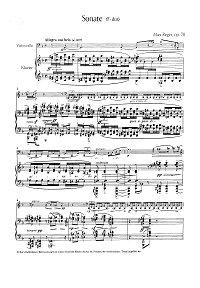Reger - Cello Sonata N3 F-dur op.78
|
Reger - Sonata N3 for cello and piano. You can download the sheet music Reger - Sonata N3 for cello and piano on this page.
The Cello Sonata No 3 in F major Op 78 was composed and published in 1904. By any standards it is a major work, and it is clear from the outset of the vivacious first movement that Reger's Brahmsian aspects have retreated into the background in the face of a complex and progressive stylistic advance. The piano's excited thrumming in the initial bars turns into a persistent sextuplet figuration that is contrasted by both instruments with martial dotted rhythms while urgent melodic figures soar and plunge. This opening subject group unfolds almost on the wing, voluble and turbulent. The long-breathed tranquillo second subject brings much-needed contrast, but only for a moment: the two contrasted characters, hectic and tranquil, alternate and arrive at a third idea, marked by steady piano chords, which concludes what has in fact been a very brief exposition section.
To download PDF, click the "Download PDF" button below the appropriate sheet music image.
To view the first page of Reger - Sonata N3 for cello and piano click the music sheet image.
|
| PDF format sheet music |
|
|
|
Cello part: Missed
|
Piano part: 49 pages. 6879 K
|
 |
 |
|
|
|
Download PDF (14.99
€) |
|
The scherzo, marked Vivacissimo, starts with a low repeated C pizzicato in the cello, and any suspicions that the movement might be inspired by the scherzo of Brahms's F minor Piano Quintet are immediately confirmed by the piano's sinister chromatic response and the staccato rhythmic writing thereafter. Though the cello plays muted throughout, this is a more capricious, roughly playful and perhaps grotesque movement than Brahms's highly driven invention, however. It is also much shorter, arriving swiftly at a tenderly melodic trio (fileno mosso) played unmuted. The scherzo music is extended on its reappearance, the cello's pizzicato tolling away sepulchrally in the final bars of what is a brilliant and unusual invention.
There follows a substantial Andante con variazioni. Reger was a master of variation-form, as his many sets of variations for piano or orchestra or organ, or the variation-finale of his Clarinet Quintet, readily attest. The intriguingly flexible, thirteen-bar theme starts out as a calm, almost hymn-like melody, the first half on the cello, the second on the piano. The six variations (most of them concluded by a rising fourth, pizzicato, on the cello) progressively shorten the note-values and elaborate upon the main melody's simplicity, roving chromatically further afield and becoming more dance-like and effervescent. The delightful sense of give-and-take between the two instruments is a most attractive feature of this highly inventive movement. Variation 5 is the heart of the piece, an apparently slow variation beginning with antiphonal solo exchanges between the players and then recalling the hectic atmosphere of the first movement, after which Variation 6 is distinguished by the rippling, purling scalic passages of the piano part, which flow into a short coda briefly recalling the variation-theme's opening.
The finale, marked Allegro vivace, brings emotional relaxation in the form of a cheerful rondo: an alternately ambling, capering, nostalgic, occasionally rather garrulous movement in a scherzo-like § time, driving at last to a decisive and good-humoured conclusion. |
|